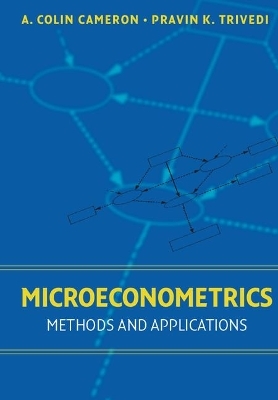
Microeconometrics
Cambridge University Press (Verlag)
978-0-521-84805-3 (ISBN)
This book provides the most comprehensive treatment to date of microeconometrics, the analysis of individual-level data on the economic behavior of individuals or firms using regression methods for cross section and panel data. The book is oriented to the practitioner. A basic understanding of the linear regression model with matrix algebra is assumed. The text can be used for a microeconometrics course, typically a second-year economics PhD course; for data-oriented applied microeconometrics field courses; and as a reference work for graduate students and applied researchers who wish to fill in gaps in their toolkit. Distinguishing features of the book include emphasis on nonlinear models and robust inference, simulation-based estimation, and problems of complex survey data. The book makes frequent use of numerical examples based on generated data to illustrate the key models and methods. More substantially, it systematically integrates into the text empirical illustrations based on seven large and exceptionally rich data sets.
A. Colin Cameron is Professor of Economics at the University of California, Davis. He currently serves as Director of that university's Center on Quantitative Social Science Research. He has also taught at the Ohio State University, and held short-term visiting positions at Indiana University at Bloomington and at a number of Australian and European universities. His research in microeconometrics has appeared in leading econometrics and economics journals. He is coauthor with Pravin Trivedi of Regression Analysis of Count Data (Econometric Society Monograph series No. 30, Cambridge University Press). Pravin K. Trivedi is John H. Rudy Professor of Economics at Indiana University at Bloomington. He has also taught at The Australian National University and University of Southampton, and has held short term visiting positions at a number of European universities. His research in microeconometrics has appeared in most leading econometrics and health economics journals. He coauthored Regression Analysis of Count Data with Colin Cameron and is on the editorial boards of the Econometrics Journal and the Journal of Applied Econometrics.
1. Introduction; 2. Causal and non-causal models; 3. Microeconomic data structures; 4. Linear models; 5. ML and NLS estimation; 6. GMM and systems estimation; 7. Hypothesis tests; 8. Specification tests and model selection; 9. Semiparametric methods; 10. Numerical optimization; 11. Bootstrap methods; 12. Simulation-based methods; 13. Bayesian methods; 14. Binary outcome models; 15. Multinomial models; 16. Tobit and selection models; 17. Transition data: survival analysis; 18. Mixture models and unobserved heterogeneity; 19. Models of multiple hazards; 20. Models of count data; 21. Linear panel models: basics; 22. Linear panel models: extensions; 23. Nonlinear panel models; 24. Stratified and clustered samples; 25. Treatment evaluation; 26. Measurement error models; 27. Missing data and imputation; A. Asymptotic theory; B. Making pseudo-random draw.
| Erscheint lt. Verlag | 9.5.2005 |
|---|---|
| Zusatzinfo | 101 Tables, unspecified; 43 Line drawings, unspecified |
| Verlagsort | Cambridge |
| Sprache | englisch |
| Maße | 185 x 263 mm |
| Gewicht | 1780 g |
| Themenwelt | Wirtschaft ► Volkswirtschaftslehre ► Ökonometrie |
| Schlagworte | Mikroökonometrie |
| ISBN-10 | 0-521-84805-9 / 0521848059 |
| ISBN-13 | 978-0-521-84805-3 / 9780521848053 |
| Zustand | Neuware |
| Haben Sie eine Frage zum Produkt? |
aus dem Bereich


